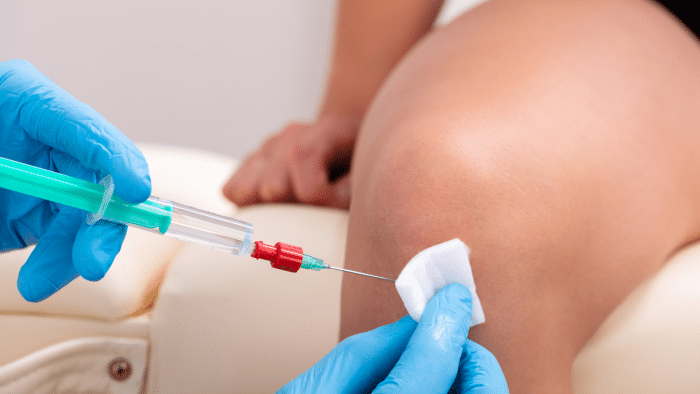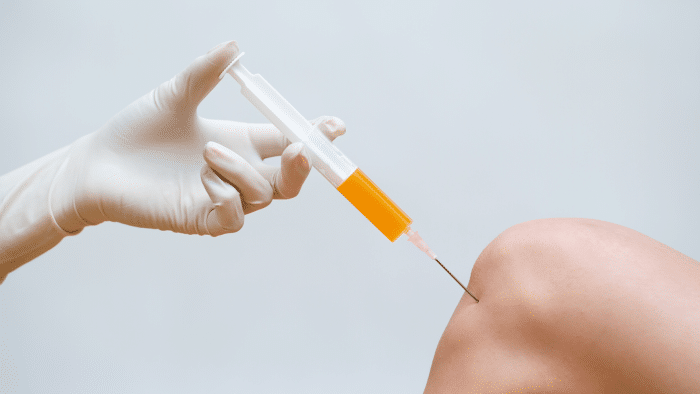
A comprehensive review of viscosupplementation in knee osteoarthritis reveals that viscosupplementation is more effective than placebo and more effective than NSAIDs and corticosteroids in pain reduction and improved functionality. However, guidelines recommend neither for nor against its use, demonstrating variability in the existing evidence base.
Orthovisc, a type of viscosupplement, is similar to the fluid surrounding your body’s joints. This fluid acts as a lubricant and shock absorber for the joints. Orthovisc is used to treat knee pain caused by osteoarthritis and is usually given after other arthritis medications have been tried without success.
This article will explore Orthovisc’s prescribing information, including usage, dosage, side effects, and warnings.
Key Takeaways
- Orthovisc is a viscosupplement used for the treatment of knee osteoarthritis.
- It provides lubrication and cushioning to the knee joint, reducing pain and improving mobility.
- Patient selection, proper administration, and post-injection care are crucial for successful treatment with Orthovisc.
- Understanding the indications, contraindications, dosage, potential side effects, and clinical evidence is essential for effectively prescribing Orthovisc.
About: Doctor Medica is your trusted supplier of top-quality dermal fillers, viscosupplements, and more for your medical practice. We offer genuine products from leading brands at the lowest prices. Contact Doctor Medica today if you want to buy Orthovisc for your practice.
What is Orthovisc?
Orthovisc is a type of viscosupplement made to help with knee pain caused by osteoarthritis. This clear, sterile solution contains hyaluronan, a substance drawn from rooster combs.
Doctors use it for patients who haven’t found relief from other forms of treatment. It stands out because it gives the joint more hyaluronic acid than any similar treatment.
Orthovisc acts like a lubricant and cushion for the knee joint. It contains hyaluronan, a substance pulled from rooster combs, which helps with joint movement. This gel-like fluid mimics the body’s joint fluid, making it easier for knees to move without pain.
Indications for Orthovisc
Knowing the approved indications for Orthovisc helps us understand who can benefit most from this treatment. Selecting suitable patients is vital to successful outcomes with Orthovisc.
- Knee osteoarthritis must be confirmed in all patients considered for Orthovisc, ensuring they fit the primary indication.
- Patients should have tried and found no relief from conservative treatments, like physical therapy or pain relievers.
- A good candidate has no allergies to hyaluronic acid products, avoiding potential adverse reactions.
- Ideal patients are those who do not respond well to simple analgesics or are unable to take them due to other health issues.
- The patient’s overall health and knee structure should support the likelihood of benefitting from hyaluronic acid injections.
- Assessing joint inflammation is vital; those with active synovitis might need to address this condition before receiving Orthovisc.
Contraindications and Precautions

Orthovisc is a knee osteoarthritis treatment involving an intra-articular injection of sodium hyaluronate. It’s critical to know who shouldn’t receive this treatment to avoid complications such as allergic reactions or transient hypotension.
- Patients with known allergies to sodium hyaluronate should not receive Orthovisc. This can prevent severe allergic or anaphylactic reactions.
- During the consultation, healthcare providers can compare Orthovisc to Synvisc or similar treatments to give patients the full picture of viscosupplementation.
- Those with infections or skin diseases around the injection site are also contraindicated. Such conditions could worsen or spread with the injection.
- Individuals showing signs of bleeding disorders must avoid Orthovisc injections, as these conditions can lead to an increased risk of bleeding and bruising at the injection site.
- Pregnant or breastfeeding women should consider other options since safety in these groups has not been established.
- Avoid administering Orthovisc in joints other than the knee because it is designed for osteoarthritis.
- People who have had previous adverse events related to injectable therapies might also face higher risks with Orthovisc.
Dosage and Administration

Orthovisc is a treatment for knee osteoarthritis delivered through an injection into the knee joint. Only trained medical professionals should perform this procedure, ensuring the entire contents of the syringe go into one knee, with a separate syringe for each knee if treating both.
- Confirm patient eligibility to ensure they are suitable candidates for Orthovisc treatment.
- Before beginning the injection procedure, gather all necessary materials, including gloves, antiseptic wipes, and the Orthovisc syringe.
- Palpate the knee joint to find the area where fluid accumulation is most prominent and select the proper injection site.
- Cleanse the skin over the injection site thoroughly with an antiseptic wipe to reduce infection risk.
- Use accepted knee injection techniques to ensure correct delivery of Orthovisc into the joint space without damaging surrounding tissues.
- Administer Orthovisc slowly to avoid discomfort or pressure build-up within the joint.
Post-Injection Care
Orthovisc injections can help ease knee pain from osteoarthritis. Proper care after the injection is critical to recovery and best results.
- Ice the knee for quick relief if stiffness lasts more than 4 hours post-injection.
- Keep the knee dry; avoid soaking in water for 48 hours after getting the shot.
- Take it easy; limit heavy activities to give your knee time to heal.
- Watch the injection site for signs of redness, swelling, or infection.
- Use pain relievers recommended by a doctor if you need them for discomfort.
- Wear comfortable footwear that supports your knees during recovery.
- Schedule a follow-up appointment with your doctor to check on your progress.
- Listen to your body; if something feels wrong, reach your healthcare provider immediately.
Potential Side Effects

Orthovisc can cause some common side effects. These include joint pain, swelling, and redness where the shot was given. People might also feel warm or notice a rash, itchiness, and bruising around the injection site.
Side effects like discomfort and tenderness at the injection site are typical. Swollen joints and skin irritation may also occur. Patients should report any ongoing or worsening issues to their healthcare provider.
Managing side effects is vital to the successful use of Orthovisc. Recognizing when these side effects become dangerous is crucial for patient safety.
Clinical Studies and Evidence
Studies show that Orthovisc helps ease knee pain in those with osteoarthritis. This comes from its ability to lubricate and cushion the joint. Researchers have compared it to other treatments, like hyaluronic acid injections, to see how well it works. Moreover, rigorous testing in the U.S. has shown us how well Orthovisc works and how safe it is for people with knee osteoarthritis (OA).
Conclusion
Orthovisc is a crucial solution for managing knee pain from osteoarthritis. It’s crafted from high-quality hyaluronic acid and aims to comfort those with this condition.
With its specific dosing and administration guidelines, healthcare providers can help patients find relief through injections. While side effects may occur, they are typically manageable.
Consulting with a healthcare provider is essential to determine if Orthovisc is the right choice for an individual’s knee pain treatment plan.
FAQs
1. What is Orthovisc used for?
Orthovisc helps ease knee pain caused by osteoarthritis.
2. How is Orthovisc given to patients?
A doctor injects Orthovisc directly into the knee joint.
3. Who should not use Orthovisc?
People with allergies to bird proteins, feathers, or egg products should avoid using Orthovisc.
4. How many injections of Orthovisc do I need?
Usually, patients get 3 to 4 injections, one week apart.
5. Can there be side effects from using Orthovisc?
Yes, some may experience pain, swelling at the injection site, or headaches after getting Orthovisc.
References
U.S. Food and Drug Administration. (2004). Summary of safety and effectiveness data (SSED). Retrieved from https://www.accessdata.fda.gov/cdrh_docs/pdf3/p030019c.pdf
Peck, J., Slovek, A., Miro, P., Vij, N., Traube, B., Lee, C., Berger, A. A., Kassem, H., Kaye, A. D., Sherman, W. F., & Abd-Elsayed, A. (2021). A Comprehensive Review of Viscosupplementation in Osteoarthritis of the Knee. Orthopedic reviews, 13(2), 25549. https://doi.org/10.52965/001c.25549
Related Articles
Joanna Carr
Revolax for Lips – Adds Volume and Fullness
Revolax is a dermal filler that can add volume and fullness to the lips, providing a natural and enhanced appearance.
Joanna Carr
What Is Lemon Bottle Fat Dissolving and How Does It Work?
Learn how Lemon Bottle fat dissolving injections work, including their active ingredients like riboflavin and bromelain. Explore the lipolysis process...
Joanna Carr
SoftFil Precision – A Guide to This Advanced Dermal Filler Technique
Explore Softfil Precision—a comprehensive guide to this advanced dermal filler technique, designed for precise and natural-looking results in facial r...


